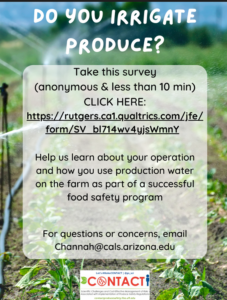Do you irrigate produce?
Have questions about Subpart E or agricultural water?
The On-Farm Food Safety Team is involved in a national survey to find out:
- Does the produce industry understand the rule?
- What areas of the rule are still unclear to the industry.
- How preharvest water is used and treated on farms across the U.S.
This survey will help us get a better understanding of what you know and how extension educators can assist the industry. Please take a few minutes and fill out the survey by clicking on the image to the right.
